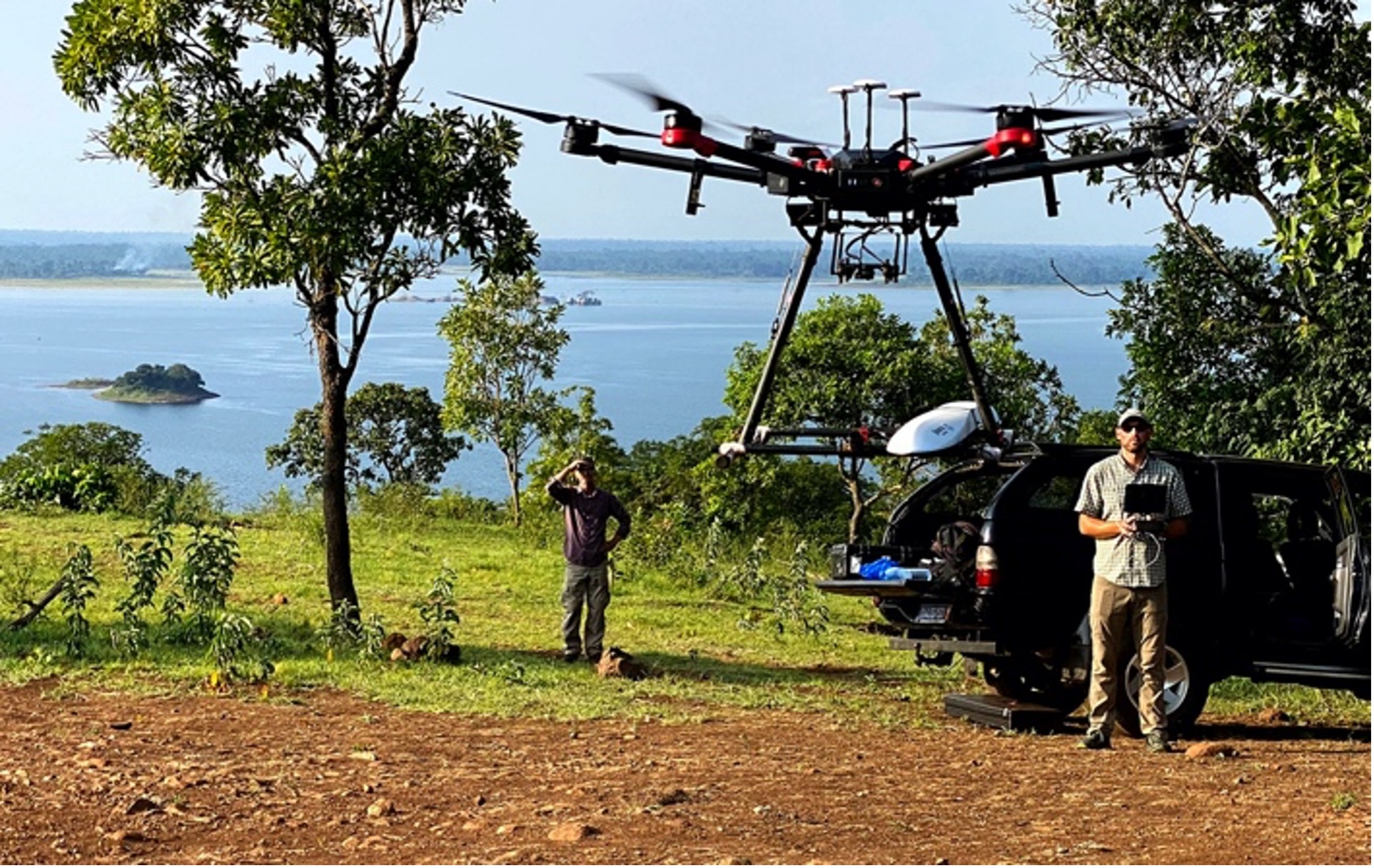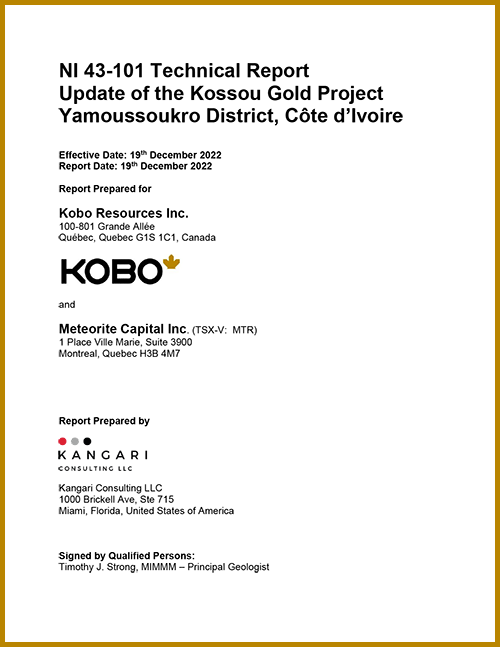
Kossou Gold Project
- Location: Yamoussoukro, Côte d’Ivoire
- Stage: Diamond Drilling
- Ownership: 100%
- Land Package: 110.2 km2
- Mineral: Gold
- Status: Exploration
- Infrastructure: Well-established roads, water, and power access, skilled labour
Kobo’s primary objective is to focus on the exploration and development of the Kossou Gold Project, which covers 110.2 km2. The Kossou Gold Project is located in the Yamoussoukro and Bouaflé regions of central Côte d’Ivoire. The permit is located approximately 22 km to the northwest the capital city of Yamoussoukro and 250 km the financial capital of Abidjan. Importantly, key gold showings are located within 7 to 10 kilometers of the Yaouré Gold Mine open pits and process facility and are connected by a well-established road.
Signficant Gold Results from the First Diamond Drill Program at the Kossou Gold Project
The Company has completed the first phase of diamond drilling at the Kossou Gold Project, which comprised of 4,367.6 m of diamond drilling in 25 holes, targeting the Company’s three highly prospective gold targets: the Road Cut Zone, the Jagger Zone and the Kadie Zone. Each drill hole has intersected gold-bearing shear zones, consistent with Kobo's successful RC drilling in 2023 and further supporting the Company's geological interpretation study conducted in the same year.
The assay results across all three zones are highly encouraging, confirming robust gold intercepts with notable high-grade sections as anticipated. This consistency reinforces the reliability of Kobo's geological models and strengthens our confidence in Kossou’s prospects, forming a strong foundation for further diamond drilling H2 2024.
Highly Prospective Zones at the Kossou Gold Project

Proximity to Nearby Operator Considered an Asset
Our immediate proximity to the Yaouré Gold Mine operated by Perseus Mining offers Kobo a significant advantage in terms of development options as the Company progressesits Kossou Gold Project. There is significant infrastructure already in place which provides Kossou with potential options if an economic deposit can be delineated.
As per the Perseus Mining website, the Yaouré Gold Mine has Measure and Indicated Resources of 2.4 million ounces gold and Proven and Probable Reserves of 2.07 million ounces gold at 1.73 g/t Au. The Yaouré Gold Mine poured its first gold in December 2020 and declared commercial production in March 2021. The mine is expected to produce more than 210,000 oz gold per year over the first 5 years with an average AISC of US$1,104 per ounce. Overall mine life is currently estimated at 12 years.
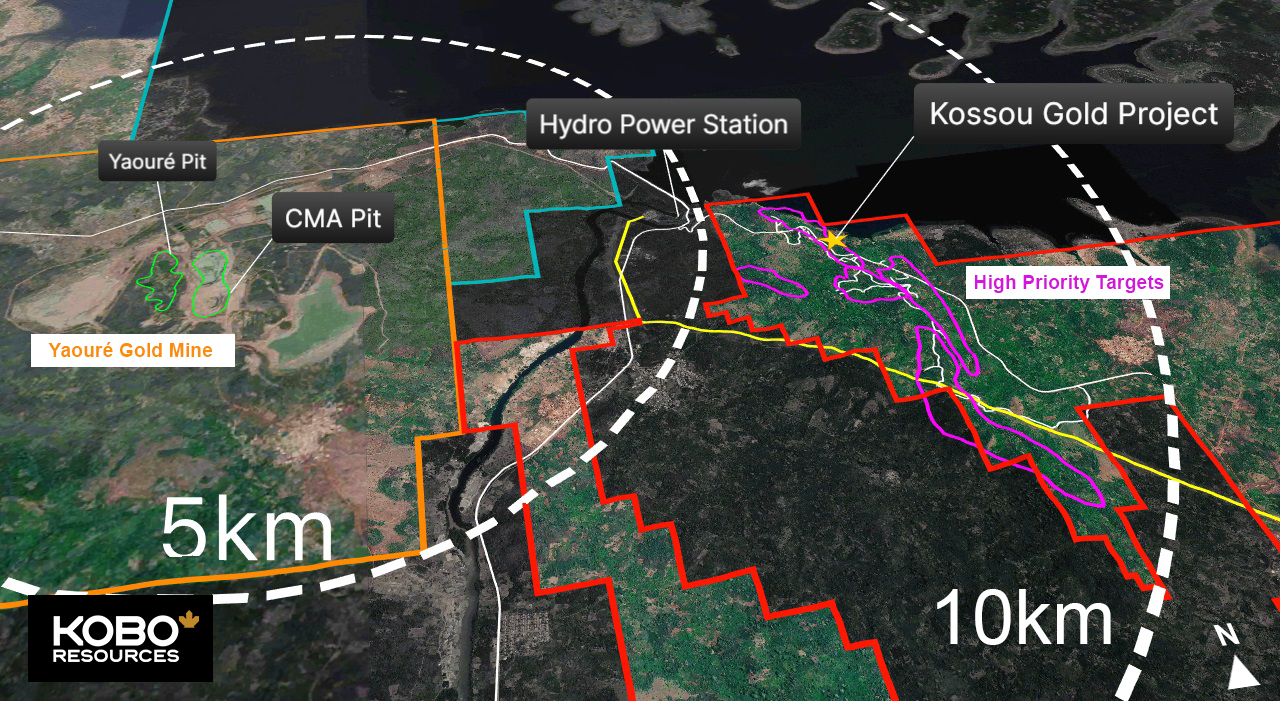
Jagger Zone
The Jagger Zone represents the largest and strongest gold soil geochemical anomaly yet discovered at Kossou. The Company successfully completed 25 reverse circulation (RC) drill holes totaling 3,164 meters and 5 diamond drill holes covering 1,219 meters, identifying gold mineralization across a strike length of 1,400 m. Significant gold mineralisation has been intersected in each hole drilled to date.
Jagger continues to show broad zones of gold mineralisation with higher grade sections within a strong north-south shear zone. High grade gold mineralization associated with N-S shear parallel brecciated veins and east-west to northwest crosscut by “V2” vein sets are present at the Jagger Zone. The brecciated vein material at this target has been mapped over 700+ m strike length.
Key Jagger Zone RC and Diamond Drill Results
- KRC009: 48 m at 1.03 g/t Au incl. 13 m at 1.70 g/t Au
- KRC011: 19 m at 2.03 g/t Au incl. 6 m at 4.00 g/t Au
- KRC002: 20 m at 1.87 g/t Au, incl. 3 m at 6.28 g/t Au
- KDD0002: 15.1 m at 1.03 g/t Au incl. 6.3 m at 1.67 g/t Au
- KDD0001: 38.2 m at 1.55 g/t Au incl. 3.70 m at 11.82 g/t Au
- KDD0021: 14 m at 2.91 g/t Au incl. 10 m at 3.96 g/t Au
- KDD0022: 6 m at 5.47 g/t Au incl. 1 m at 30.90 g/t Au
- KDD0023: 4 m at 2.79 g/t Au incl. 1 m at 9.51 g/t A
Collar Location Map — Jagger Zone

Jagger Zone: Section 700
Geological interpretation of the diamond drill holes on section JZ 700 shows multiple north striking shear zones (Jagger Shear Zone) hosted within a generally north-trending package of massive to pillowed basalts with minor intrusive and interflow sedimentary units. Mineralisation remains open to depth and south of this section.
.png)
Road Cut Zone (RCZ)
The RCZ was initially discovered during early reconnaissance of the Permit and lies within strongly altered volcanic rocks heavily cut by quartz and quartz-carbonate veins/veinlets. The Company completed 1,699 m of reverse circulation (RC) drilling in 13 holes and 15 diamond drill holes totaling 2,300 m, defining broad zones of gold mineralization, including high-grade sections, within sheared and silicified volcanic units over a strike length of 850 m.
Gold mineralisation has been confirmed in clearly defined mineralised zones to a depth of 80 m below surface. Gold in soil geochemistry indicates that this target can be traced over a strike length of 1.7 kilometers and is a prime target for continued drilling.
Key Road Cut Zone RC and Diamond Drill Results
- KRC040: 12 m at 1.49 g/t Au incl. 2 m at 4.75 g/t Au
- KRC044: 13 m at 2.10 g/t Au incl. 9 m at 2.94 g/t Au
- KRC022: 8 m at 3.18 g/t Au incl. 2 m at 8.38 g/t Au
- KDD0014: 9 m at 4.27 g/t Au
- KDD0012: 11 m at 1.71 g/t Au
- KDD0015: 6 m at 2.48 g/t Au incl. 1 m at 11.60 g/t Au
- KDD0017: 5 m at 4.30 g/t Au incl. 1.0 m at 20.00 g/t Au
- KDD0016: 2 m at 7.26 g/t Au
Collar Location Map — Road Cut Zone

Kadie Zone
Ongoing exploration efforts have identified three strong geochemical anomalies 200 m, 400 m, and 600 m west of the main Jagger Zone named Kadie 1, Kadie 2, and Kadie 3. The Kadie Zone targets have structural and lithological characteristics similar to those found at the prospective Jagger gold bearing shear zone.
In total, the combined Kadie Zone soil anomalies extend approx. 1 km along strike.
Key Kadie Zone Drill Results
- KDD0005: 9 m at 23.89 g/t Au, incl. 1 m at 210 g/t Au
- KDD0024: 7 m at 1.91 g/t Au, incl. 2 m at 5.76 g/t Au
Collar Location Map — Kadie Zone

Inaugural 2023 Exploration Program Proved Successful
Kobo completed initial drilling at its Kossou Gold Project located in Cote d’Ivoire, West Africa with 5,887 m drilled in 53 RC drill holes and 80 trenches (~5,492 m). Drilling and trenching successfully confirmed significant gold mineralisation at the Road Cut Zone and additional strong gold mineralisation within the Jagger Zone. Further exploration work also elevated the Kadie Zone to drill status.
Summary of 2023 RC Drill Program
.png)
Summary of 2023 Trench Program
Kobo's trenching program returned signifcant gold results in all three of its highly prospective zones. See a highlighted summary of each zone below:
Jagger Zone: 34 trenches (2,594 m)
- KTR028: 29 m at 6.42 g/t Au incl. 8 m at 11.44 g/t Au
- KTR043: 68 m at 1.83 g/t Au incl. 11 m at 6.80 g/t Au
- KTR030: 16 m at 3.32 g/t Au
- KTR030a: 19 m at 5.07 g/t Au incl. 2 m at 42.75 g/t Au
- KTR044: 7 m at 1.18 g/t Au
- KTR047: 14 m at 2.67 g/t Au, incl. 10 m at 3.38 g/t Au
- KTR042: 21 m at 1.74 g/t Au, incl. 16 m at 2.20 g/t Au
Higlighted Trench Collar Map: Jagger Zone

Road Cut Zone: 48 trenches (1,745 m)
- KTR059: 47 m at 3.92 g/t Au incl. 21 m at 4.70 g/t Au
- KTR049: 33 m at 4.68 g/t Au incl. 11 m at 9.37 g/t Au
- KTR070: 28 m at 4.44 g/t Au incl. 18 m at 6.54 g/t Au
- KTR086: 5 m at 8.56 g/t Au incl. 3 m at 12.61 g.t Au
- KTR082: 22 m at 2.76 g/t Au incl. 2 m at 22.36 g/t Au
- RCZ-1: 18.2 m at 4.64 g/t Au
- RCZ-3: 11 m at 1.45 g/t Au
Higlighted Trench Collar Map: Road Cut Zone

Kadie Zone: 10 trenches (1,275 m)
- KTR036: 11 m at 5.16 g/t Au incl. 4 m at 12.92 g/t Au
- KTR065: 7 m at 4.78 g/t Au incl. 5 m at 6.08 g/t Au
- KTR063: 4 m at 13.08 g/t Au incl. 1 m at 50.70 g/t Au
- KTR064: 16 m at 1.89 g/t Au incl. 8 m at 2.64 g/t Au
- KTR038: 10 m at 2.27 g/t Au
Higlighted Trench Collar Map: Kadie Zone

Historic Drilling
Kobo began exploration efforts in 2016 initially examining an alluvial/eluvial deposit in what is designated the “Beach Zone”. A series of 164 pits were dug and the contents of the pits were hand washed for evidence of gold. All but nine pits contained visible gold.
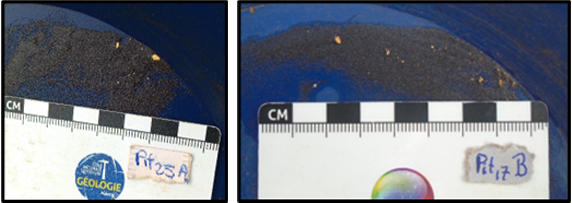
Subsequent mapping and prospecting work led to the discovery of the RCZ. Strong rock sampling results and early soil geochemical survey results showed indications of significant potential mineralisation which led Kobo to expand this exploration program. Additional mapping, rock and soil sampling and trenching resulted in the delineation of at least 7 significant zones of potential gold mineralization. Exploration work is ongoing.
Geochemistry
The Kossou Gold Project contains over 7+ km of geochemical anomalies to be explored:
- Road Cut Zone ~ 1.6 km strike
- Jagger Zone ~2.0 km strike
- Jagger Zone South ~2.8 km strike
- Kadie Zone ~ 1km in three distinct anomalies
All geochemical targets are supported with rock samples or extensive artisanal mining. These geochemical targets, along with trenching and surface mapping formed the basis of the 2023 drill program.

Airborne Magnetics (Drone) Survey
Between August 13 and August 28, 2020, a 1,195.4 km Unmanned Aerial Vehicle (“UAV”) magnetic survey was completed over a portion of the permit by MWH Geo-Surveys International Inc. of the USA (“MWH”). MWH utilized a DJI M600 Pro drone, a Geometrics MagArrow (cesium vapor magnetometer) and GEM System GSM19 base station. Survey lines were flown on 50 m spacing and at a mean terrain clearance of 62.3 m.
Magnetic Data
Processing and analysis of the survey results have shown good correlation with geochemical, trench and surface rock sampling results and have aided in an advancement of the geology of the project.
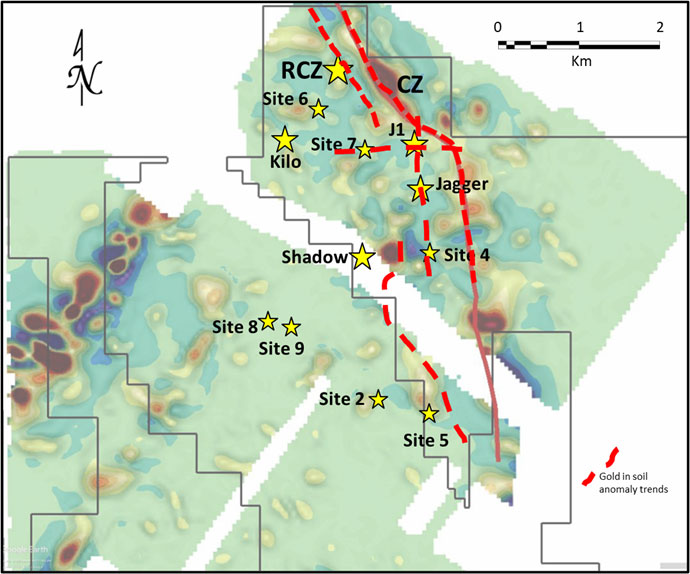
Geological and Structural Study
In March 2021, Kobo contracted InnovExplo to carry out a field mapping and a structural study to gain a better understanding of the local geological environment and controls on mineralisation. Result of the study were very positive.
Geological observations and structural data indicate a structural corridor that links kn showings and is coincident with both the magnetic interpretation, rock and soil sampling results. The work also postulated a second structural corridor west of the main area of interest, linking the newly discovered Kilo and Shadow zones.
Gold mineralization occurs within quartz and quartz/carbonate veins/veinlets and disseminations in the host volcanic rocks associated with tensional ‘en echelon’ and conjugate shear and fracture networks.


